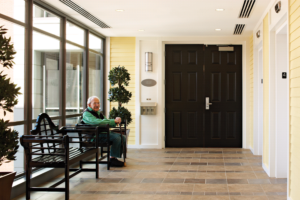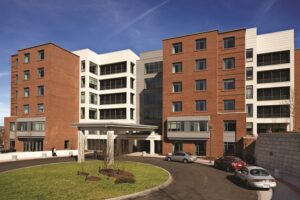By David Wilkening, Contributing Writer

Photo/submitted
CHELSEA – When Steve McAlilly left his Mississippi home for a Leading Age convention in Los Angeles more than two decades ago, he expected to hear a lot of talk about senior care. No surprise there, as Leading Age is a non-profit organization representing widely-ranging senior services.
What he did not expect, however, was that he would become one of the co-founders of the Green House Project, which would later open the Boston-area Leonard Florence Center in Chelsea. When the center opened its doors in 2010, it was the first urban model Green House skilled nursing facility in the country. It was also the only nursing home dedicated to residents for individuals living with ALS and MS (Multiple Sclerosis).
Celebrating its tenth anniversary in February of last year, the center named after the late Chelsea philanthropist Leonard Florence was widely praised as “innovative” and “revolutionary.” The designations were due to its basic existence. It’s unlike any other nursing home. The facility at 65 Captains Row was praised for providing the health care and other amenities for all residents for ALS and MS sufferers. And more importantly, perhaps, it allows older individuals to live as independently as possible.
An inspirational speech
At the California conference, McAlilly remembers being impressed with hearing a speech by Dr. William H. Thomas. “He said the problem with nursing homes is loneliness, helplessness and boredom,” McAlilly said. “It is better to live in a house than a warehouse.” Thompson is the Harvard-educated founder of The Eden Alternative, a philosophy and program that de-institutionalized nursing homes in all 50 states and worldwide over the past 20 years.
The two became friends. Thomas went to Mississippi, where McAlilly was already planning the building of new nursing homes. Their collaboration led to the multi-million-dollar plans for a 140-bed facility being radically revised.
A different approach
“What Bill said haunted me. He described smaller homes with 10 or 12 adults with private rooms and baths that also provided needed medical care. I told my board we were throwing millions away unless we make changes, and they had the courage to support the concept,” he said.
The result was that Mississippi Methodist Senior Services (MMSS), headquartered in Tupelo, Mississippi, became the first organization to actually implement the model. McAlilly is CEO of the organization, which operates 12 retirement campuses in Mississippi, which includes 20 Green House homes. And along with Thomas, he is recognized as one of the co-founders of Green House, which now has 360 facilities in the U.S. The homes all share basic philosophies but are not just cookie-cutter copies.
The main difference between the two senior housing concepts is in the building and planning creation phases. The Eden Alternative involves partnering with nursing homes to help them change their culture, environment and approach to care to “create a habitat for human beings rather than facilities for the frail and elderly.”
The Green House Project focuses on helping companies and individuals build or convert residential homes that can provide high levels of care in a nursing home setting.
Leonard Florence an example of ‘urban’ model

Photo/Submitted
The Leonard Florence Center overlooking Boston Harbor consists of ten 7,000-square-foot condo-style “homes” on six floors. It is an example of how the model can adapt to urban areas, said Alex Spanko, Green House’s director of communications and marketing.
“Because space was at a premium in Chelsea, the Leonard Florence team built vertically and made each floor its own ‘house.’ Each house has up to 12 residents, all in private rooms,” he said.
“A small but important tenet of the Green House model is that visitors can’t just burst into the front door. Instead, they must ring the bell and wait to be welcomed inside, just like you would do at a private residence,” he added.
Small details such as that are often found in the Chelsea facility and other Green House models. Medical care is available but there are no nurse’s stations or medical carts; the atmosphere is described as warm and welcoming.“ Green” in this case means living in a natural world surrounding, with an abundance of sunlight, greenery and outdoor access.
High ratings and favorable costs
The Chelsea facility got the highest rating of five stars from CMS.gov, the official website of the Centers for Medicare & Medicaid Services. The rating compared to the state’s average of 3.36 and a national average of 3.32. The ratings are based on various factors that include pricing, resident activities and other factors.
Subsidized by Medicare and Medicaid as well as state programs, the costs for Green House homes compare favorably with traditional nursing homes, according to Green House officials such as Susan Ryan, senior director of the Green House Project at its national office at Linthicum, Maryland.
“Published public research has compared the number of COVID-19 cases and mortality rates in Green House homes to their traditional counterparts in the same geographical area,” she said. The results were much lower infection and death rates at Green House homes.
RELATED CONTENT:
Accessory Dwelling Units: one approach to expanding senior housing options (fiftyplusadvocate.com)
Tiny houses offer unique alternative to traditional homes (fiftyplusadvocate.com)
Woburn’s Cummings Foundation supports older adults in a variety of ways (fiftyplusadvocate.com)












